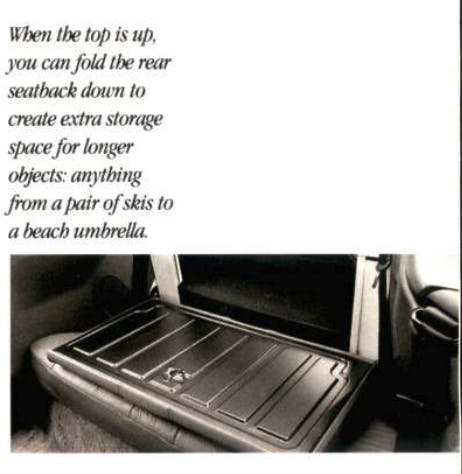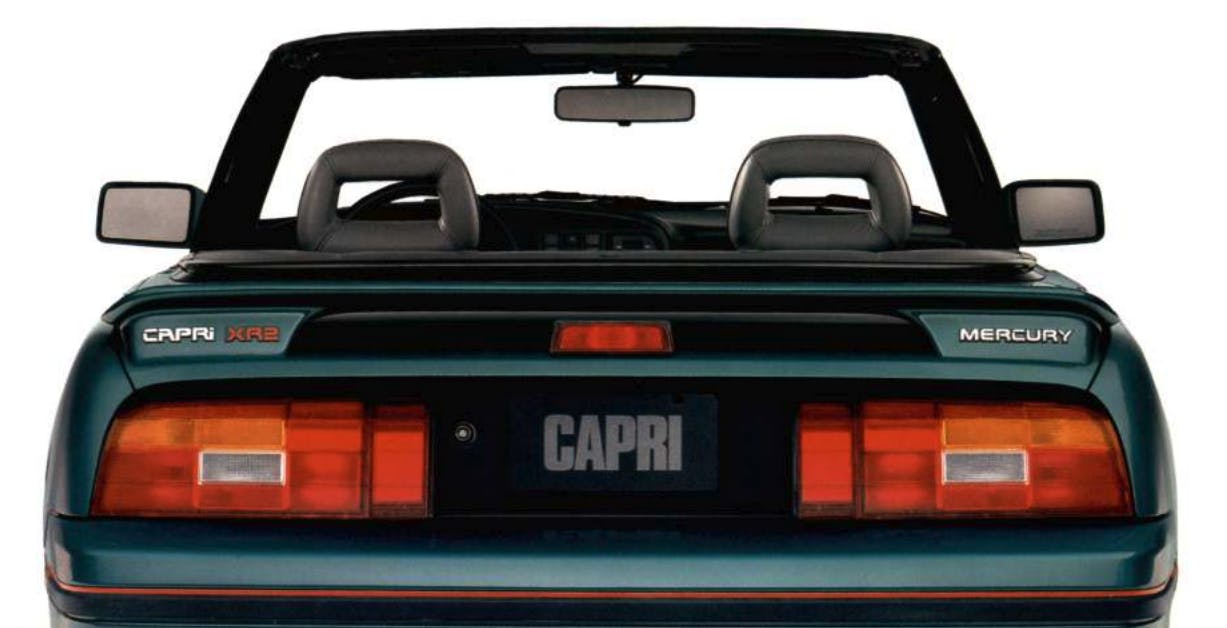Media | Articles
The Capri was slightly Allanté, somewhat Miata, and an entirely misguided Mercury
Platform sharing has been going on since the days of the Model T, which spawned everything from minimalist Runabouts to formal Doctor’s Coupes, but Ford really upped the ante by the early 1990s. You may remember one particularly impressive feat of late-’80s platform cross pollution pollination: the Cadillac Allanté, a custom-bodied E-body Eldorado that literally flew in from Italy to be assembled in America.
Luxury vibe and high-stakes budgets aside, I wager Ford’s gambit on affordable, top-down motoring was even more of an M.C. Escher–worthy supply chain. Only FoMoCo could cut up a Mazda family car, seek stylistic inspiration from two Italian design studios, source greasy bits from Mazda’s high-performance portfolio, apply the (then passé) name of Europe’s answer to the Mustang, assemble the whole lot in Victoria, Australia, and retail the resulting vehicle at dealerships still reeling from the ill-fated Merkur brand.
Boy, that’s a lot to process. With an origin story that complicated, how could the Mercury Capri not earn a spot of real estate in our hearts? There’s one big reason—but we’re getting ahead of ourselves.

In theory, the Capri had the chops to make it work. Wait, hear me out on this.
Like the cosmopolitan Allanté, the Capri eschewed in-house notions from Ford designers for a final exterior penned by Carrozzeria Ghia. While Italdesign lost the bid for the body, its handiwork is present in the Capri’s minimalist yet purposeful interior. While the somewhat sleek skin may not have the proper proportioning of the rear-wheel-drive, low-slung, and long-hooded Miata, the Mazda 323–based platform has a fair bit of cred thanks to Mazda’s admirable efforts in Group A rally racing. There was even a turbocharged engine (XR2 model) with a mandatory manual transmission, a combination unavailable in the Miata.
Marketplace
Buy and sell classics with confidence
The Capri was unlike its competition, and that evaluation doesn’t necessarily damn it with faint praise. That’s because the Capri was far more practical than a mere two-seat sports car. Even better, the rear seat—useless as it may be for grown humans—sported a hard-sided back, which folded to accomodate a significant amount of cargo, should the top remain up to allow full access to the trunk. The Capri’s standard tonneau cover topped the Miata’s exposed affair, while an optional hard-top secured four-season fun. There was even an optional, speedster-like cabin-cover so Capri owners can play Porsche Speedster in foul weather. You know, weather that’s ideally suited to wrong-wheel-drive propulsion.
But what made the Capri stand out was the aforementioned huffer, feeding extra air to the Mazda-sourced, 1.6-liter mill. The DNA is similar to what’s found in the Mazda 323 GTX, sans the all-wheel-drive drivetrain. A tragedy, but all automotive efforts inspire a cult-like following. Well, eventually. And the Capri XR2 deserves the following it has garnered, even becoming a credible threat in 24 Hours of Lemons races. Well, at least when the events are staffed with Spec Miata racers and seasoned B-series engine builders. Here’s a telling quote from one of the race Capri’s caretakers:
What can I say? After changing literally everything in the suspension and upping the boost to unimaginable levels, it’s the front-wheel drive Miata fighter it was always destined to be. –Zachary Fox
My bias is clear, but Mostly Harmless Racing and their #42 Capri XR2 shows us this ragtop had more potential than we knew.
So feel free to consider a modified Capri XR2 as a legitimate threat to a Miata, provided there are enough straights to let the turbo really sing. Who knows, maybe there are enough people willing to embrace the benefit and put Mercury on their list. No matter, the folks at Motorweek got their hands on a 1994 Mercury Capri XR2 as a swan-song review for this star-crossed captive import of Japanese, Italian, German, Australian, and American heritage.
The revised front/rear bumpers and bolder rear spoiler weren’t fooling anyone, but the 0-to-60 sprint of 8.0 seconds clearly meant the visually louder tail lights were all a 1.6-liter Miata would ever see at a stop-light grand prix. The 16.1-second quarter-mile time was also superior, and a strong 88-mph trap speed suggested the Miata had better make some headway in preparation of a racetrack’s wide-open straight before the checkered flag.

Turbo torque is irrelevant for most North American buyers of Lincoln-Mercury’s little droptop, but the $13,190 asking price ($14,900 for the turbocharged XR2) made Motorweek lament the passing of the cheapest example of the breed on the market. But I doubt there were many sleepless nights or tear-soaked cheeks upon the Capri’s passing, and its singular party trick was rendered pointless by the 1994 introduction of the 1.8-liter Miata. There could only be one winner, and it was clearly the product of thoroughbred Mazda engineering and pureblood roadster design.
In the end, the Capri’s strengths were also its downfalls. The price was right, but even with a turbo, nothing could stop the Miata’s righteous march to the hallowed halls of sports car perfection. Who knows, maybe all the billable hours Mazda charged to Ford for its effort actually subsidized the Miata’s R&D costs? Ford musta written Mazda a fat check for the privilege, but they forgot one cardinal rule in the car business: The answer is always Miata.
















My sister had one back in the days. All that I remember was it would not go over 118mph and that took forever to get there. Cool little car though.
Attended a Bondurant driving class just after they moved to Arizona and they were handling a press intro of the Capri the next weekend. Being a bit cheeky I asked if I could drive one of the cars. They blanched at the suggestion but then said that Bob would take me out on the track. Second best but still good. As the car plowed and lurched around the track I was reminded that, with a skilled pilot, even pigs could fly. Never entertained the idea of buying one…
I think the FWD part hurt it amongst enthusiasts and I don’t think the basic Mazda parts binning helped either. Finally anything Mercury seemed to do in the 80’s that was “sporty” seemed to get ignored including the Merkur stuff they tried to sell. If it had been branded a Ford it might have done better.
Every once and a while I wonder if the designers go out to the scrap heap pile of parts and say “Lets build something out of these parts as it’s here any way.” I will bet we have seen all to many tries like this that failed.
I owned a 323GTX, helped build a couple GTX rally cars, co-drove in them and a few more, and helped a bunch of people work on their GTX road cars.
The BF 323 chassis quickly becomes flippy-floppy when stressed. Rally and race cars have cages to keep them rigid. My GTX has an incredible amount of body flex when I used it on rough, gravel TSD rally roads.
A friend’s mom had a White one, with a gray interior. The styling never appealed to me, nothing looked quite right, almost like they were mashing a bunch of pieces together trying to get them to fit, the tail lights are a prime example. A LOT could have been done to improve appearances, but they seem like they are all cosmetically the same, differences being the paint color.
I had the opportunity to drive it, and it was ok, nothing I would consider getting excited about. The only other stick I drove was his Datsun 260Z, and I believe in that to get it to go into reverse you pushed down on the stick, I did just that and I broke the shifter in the Capri. The plastic piece had been replaced once before, so this time we went to Lowes and picked up some wire, and we wired the shifter into place and as far as I know they never had another problem with it.
Bought one of the first ones new. Non-turbo stick. Drove it for 90k miles with nary a problem. Great gas mileage. Car killed by a deer which jumped on and off the hood on Mulholland Drive. Scared the wits out of my wife. The deer lived. Car was totaled because hood was dented and front end was one piece. Could not straighten, there were no scrap parts or “fake” crash parts and a new front end cost more than car was worth. If not for the deer, would still probably have the car to go along with my 1968 Toyota Corona RT52.
Just my opinion – Ford’s first mistake was re-using an honorable name for a completely different concept.
The author must have one in the back of his garage, looking to unload.
Create demand by faint praise.
After writing that? No way I’d ever sell…provided its a Turbo.
The Capri XR2 took entirely too long to get to market. It started out as an idea in 1982, when it would have had as near as no competition. In 1983, the Fiesta-based Ford Ghia Barchetta showed up as a very elemental two-seat roadster based on a FWD subcompact that was well-regarded for its dynamics. Then Ford dragged its feet for seven years. In the meantime, the simple and somewhat elegant Barchetta was consumer clinicked and mission creeped into a two-plus-two convertible with anonymous styling and Australian build quality while Mazda unleashed a two-seat roadster that was almost completely without compromises. Had the Capri showed up on the market in 1986, it probably would have been reasonably successful. The economy had recovered and there was still a middle class. I remember Suzuki Samurais selling for eleven grand with a nationally advertised base price just under six thousand. Some of that exuberant spending on affordable fun cars could have been done at Mercury dealerships.
Junk then and junk now.
I’d consider picking up one that isn’t a mess…. I see a few that are a mess, going the rout of most MGs did with many short term owners.
I had a NA Miata, It was fun, but for even a basic road trip there was nowhere to put anything. I don’t need to wag my rear out that often, I’m happy driving my FWD Accord, so I guess this would be find. My Mazda Protege’ was dead reliable and good fun.
how about the early 70’s capri and if I remember I read a machanix illustrated article about a wing kit that would turn it into an airplane
As a Lincoln-Mercury dealer who did very well with these, the real problem was the 6-month wait time between submitting the order and the cars’ arrival. It was impossible to plan for (or meet) customer needs. Ford’s answer was to take ordering out of the dealer’s hands and give it to their field staff. Needless to say, the situation went from bad to worse!
Now THAT is interesting! I wonder if there was a supply chain issue “Down Under” that caused such a radical change?
I had the REAL Capri’s brand new in 71, 73 and 74. All German, no Ford badging and in 74 a great 2.8 V-6! awesome cars, then Ford in 79 took some Pinto parts and decided to make their own US version Capri. I thought at the time what an awful thing to happen and marketing wise I was correct.